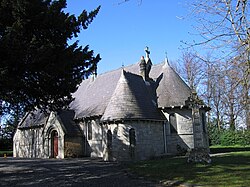Rathmichael
| Rathmichael Irish: Ráth Mhichíl | |
| County Dublin | |
|---|---|
 Rathmichael Parish Church | |
| Location | |
| Grid reference: | O232222 |
| Location: | 53°14’9"N, 6°9’20"W |
| Data | |
| Post town: | Dublin |
| Postcode: | D18 |
| Local Government | |
| Council: | Dún Laoghaire–Rathdown |
Rathmichael is a village in County Dublin. It is situated west of Shankill from which it is separated by the M50/M11 motorways. It is also the name of a parish in the barony of Rathdown.
History
The ruins of a church are found near to the remains of what would once have been one of the largest ringforts (ráth) in Ireland.[1] The church is believed to be dedicated to a saint called Mac Táil, which was later corrupted as "Michael".[2] The modern Irish name Ráth Mhichíl appears to be derived from the English corruption. Thus, Rathmichael is more likely to have come from Ráth Mhic Táil, meaning "Mac Táil's Ringfort".
At the west end of the church are the remains of a round tower, 6 feet high.[3] It has a circumference of 51 feet.[4] The tower is known locally as "The Skull Hole", a reference to the occasion when skulls and bones from the adjoining burial ground were deposited there rather than being re-interred when the graveyard was cleared to create additional space. There is a story of an underground passage that leads from the round tower to the sea and of a piper who descended into the passage playing his instrument never to be seen again.[3] The remains of a passage – possibly a souterrain – have been found close to the tower.[3]
Location and nature
Rathmichael is an affluent suburb, characterised by extensive tracts of low-density dwellings, with large houses and gardens interspersed with open areas. It rises to the west towards the hill of Carrickgollogan in the foothills of the Dublin Mountains. The chimney of the disused lead mines and the ruins of Puck's Castle on the northern flank of Carrickgollogan overlook the area
It also has the oldest house in southern County Dublin, The Old Glebe House. Jonathan Swift may have written part of Gulliver's Travels while staying here.
References
- Corlett, Christiaan (1999). Antiquities of Old Rathdown. The archaeology of south County Dublin and north County Wicklow. Bray, County Wicklow: Wordwell. ISBN 1-869857-29-1.
- Ball, Francis Erlington (1905) (pdf). A History of the County Dublin. Part 3. Dublin: Alex Thom & Co. http://www.askaboutireland.ie/aai-files/assets/ebooks/256-261_A-History-of-the-County-Dublin/259%20A%20History%20of%20the%20County%20Dublin%203.pdf. Retrieved 9 August 2010.
- Pearson, Peter (1998). Between the Mountains and the Sea. Dun Laoghaire-Rathdown County. Dublin: O'Brien Press. ISBN 0-86278-582-0.
- Donnelly, Most Rev. N. (1977). Short Histories of Dublin Parishes. Part V: Parishes of Sandyford; Glencullen; Killiney; Little Bray; Cabinteely. Dublin: Carraig Chapbooks.
